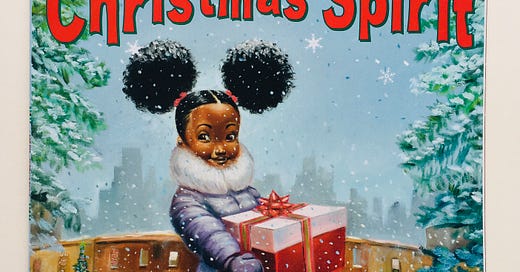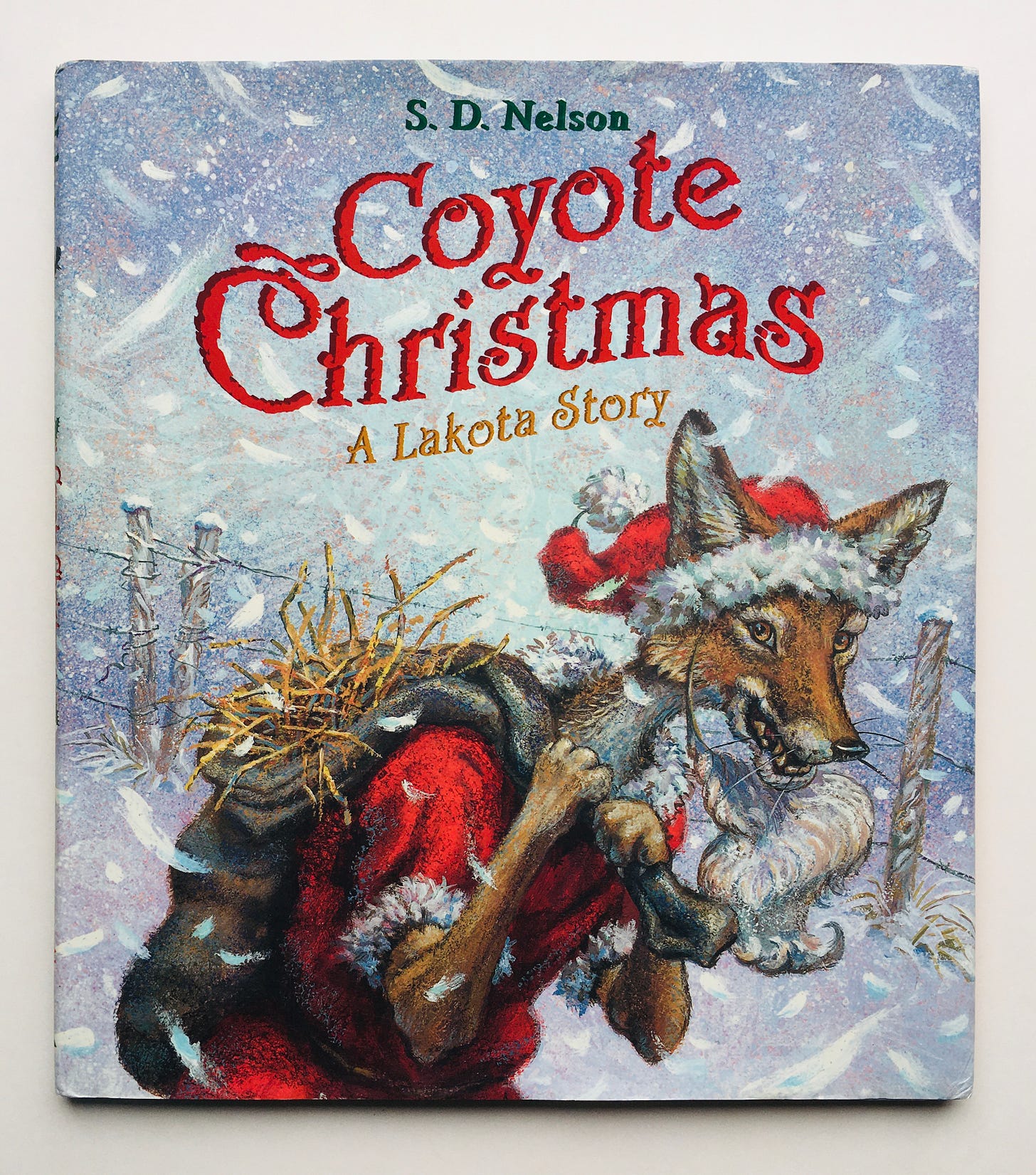Hi there!
Yes, I know I’m sending a special edition on Christmas the day before Thanksgiving and that’s kind of questionable. But I also know (because you’ve told me) that you appreciate getting these seasonal and holiday titles early, so you can request them before anyone else at the library — a small pleasure I understand completely. (Go forth and load up your hold list!)
Also, though, yay Christmas! I am an out-and-out Christmas lover — it makes me happy, and this year I am not even remotely interested in delaying pleasure; in fact I am actively running toward pleasure with both hands open, so here we are. Of course, one of my very favorite things is pulling out our giant box of Christmas books, filling our front-facing bookshelf, and letting my children loose on all our favorites that we haven’t seen for a year.
But: I do want to say happy Thanksgiving to you and your family. I’m truly grateful for your support of this newsletter — this small thing that I began in an attempt to stay sane during pandemic lockdown has brought me real, actual joy, and that’s because of you. Please know that I count you among my many blessings, not just tomorrow but every day. Thank you.
A couple things:
1️⃣ If you want more great books than what I’m about to snowball at you below, check out my two-part 2020 special edition on Christmas — since it was the first time I’d ever covered books about Christmas I jammed all our favorites in there. There are some gems, so don’t miss ‘em!
2️⃣ As always, I’ve put together handy Christmas booklists for you on both Bookshop.org and Amazon, to make it easy to order any of the titles I recommend if you’re in the market for fresh reads or holiday gifts. (The lists are identical depending on where you’d prefer to shop — I am able to include out-of-print titles on Amazon but I encourage you to support independent bookstores first, or at least too. I receive a small commission, at no additional cost to you, if you use either of these links to make a purchase — thank you!)
3️⃣ I always mention that Christmas is an entirely secular holiday for my family — we belong to no specific religion or faith system, so this is what works for us. While we do read a few books that tell the story of Christmas from a Christian perspective (mostly singing books, which I’ll include next week) they make up a small percentage of our collection and are not my focus here. If a title contains religious themes, I have made note of it.
Now, let’s point this sled in the right direction 🛷 and lean over the top of the hill into the manic whoosh of a downhill journey that is the end-of-the-year holidays. May you stay upright (unless lying down is the point) and enjoy the ride!
I Got the Christmas Spirit by Connie Schofield-Morrison, illustrated by Frank Morrison (2018)
Less a narrative and more a lively, poetic, sensorial anthem to “the spirit of the season,” this colorful romp through the city by the side of one joyous little girl is both a celebration and a reminder that Christmas is an attitude.
Morrison’s vibrant oil on canvas illustrations show “the spirit” in all sorts of ways, from the smell of roasted nuts to shivering in the wind to sitting on Santa’s lap, and Schofield-Morrison’s text includes a noise on every page — “I heard the spirit in the air. DING DONG DING. I’ve been saving the spirit all year long. JINGLE JINGLE. I sang the spirit from my heart. FA LA LA LA LA” — making this a great one for little kids, who will join in with glee after only a few readings. The little girl in this book is an example and a role model, encouraging every reader, “Peace for all, good tidings, and cheer — let’s live the spirit every day of the year.”
Yes, let’s.
Coyote Christmas: A Lakota Story by S.D. Nelson (2007)
We love a good trickster story in my family — who doesn’t? — so when I first came across this book I was delighted to see someone tell one with a Christmas twist, and Nelson, as ever, does not disappoint.
“Coyote did not know it was Christmas Eve. He only cared that his empty stomach was growling and that the shivering cold of night was settling upon the land.” He comes across a house below a hilltop on an Indian reservation and immediately decides — telling Sister Raven, who questions him from a tree — to “pay those two-legged creatures a visit and get me a free hot meal.”
As he approaches the house, the family’s guard dog tries to run him off but Coyote threatens to turn the dog into a house cat. Coyote heads for the barn, where the horses protest his presence, but he silences them by telling them he’ll turn them into pigs (right before actually turning one of the cows into an owl). There he finds some supplies — an old horse blanket, a belt, a sheepskin, a bag full of straw — which he magicks into a Santa Claus costume before heading toward his hot meal.
When Coyote knocks on the door and asks to come inside, the family welcomes him readily. He tells them he has brought presents for them all, and briefly notices that the boy is wheelchair-bound before stuffing himself silly. Sister Raven, watching from outside the window, decides in this moment that “maybe she could outdo the Trickster with a trick of her own.”
When Coyote gets up to leave, abandoning his falsely-full bag in return for the family’s generosity and kindness, he trips, and out falls a heap of presents. He’s baffled — “Giving gifts was not the trick he had intended” — but he uses the situation to his advantage, passing out the packages before sneaking out the door. Outside, an unfamiliar feeling of guilt washes over him and he begins to slink away before the door opens behind him and out comes the boy, using his new gift of walking legs.
Coyote does a triumphant jig on the cross rail of the corral before falling and doing the splits, injuring himself right where it counts as all the barnyard animals laugh, including, of course, his relative in trickster-hood, Sister Raven.
Everyone loves a good comeuppance, especially children, but there is much more to this story than that simple satisfaction and you may find yourself fielding questions: Why did Sister Raven decide to trick Coyote? Does Coyote even know it was her? Why do some people do bad things? Does everyone get what they deserve?
Nelson, a Lakota author and artist and member of the Standing Rock Sioux Tribe, has, through his striking acrylic illustrations and memorable storytelling, brought to life an enthralling and highly entertaining Christmas trickster tale not to be missed.
🎁 Present alert! 🎁
I’ll be giving away a copy of Coyote Christmas next week in Notes From the Reading Nook, which comes out every Tuesday for paid subscribers only
The Animals' Santa by Jan Brett (2014)
It’s Little Snow’s first Christmas Eve and his older brother, Big Snowshoe, assures him, “The animals’ Santa comes tonight!”
Who is the animals’ Santa? Little Snow wonders, but the rest of the animals tell him they don’t know — they never see the animals’ Santa, though they find presents from him on Christmas (Porcupine, a little bell; the raven twins, a puzzle toy; the squirrel cousins, “a tasty sack of plump acorns”) and take guesses at to who he could be. Little Snow doesn’t buy it. “Wouldn’t someone have seen his tracks in the snow?” he asks his brother, but Big Snowshoe has no suitable explanation — he simply believes.
Little Snow, frustrated and even angry at the lack of proof, snuggles down for the night, while Big Snowshoe does some quick thinking — he hangs pieces of ice in the branches of the trees to create chimes, just in case the animals’ Santa comes. His problem solving is rewarded, and everyone is awakened by the noise to spy a great, gorgeous snowy owl dropping bundles of herbs “as if falling from the moon” down onto the animals of the forest. Finally, finally, Little Snow knows that the animals’ Santa is “truly, truly true.”
Brett has a whole catalog of wonderful Christmas books — every last one of them excellent, beloved, and well worth seeking out for your own collection — but I like this lesser known one because it addresses the question in every children’s heart: is Santa real? Brett’s lush, maximalist illustrations are a joy to soak in and pore over and she outdoes even herself with marvelous portraits of the natural world in winter, complete with sumptuous detail of every animal (right down to their facial expressions, which are simply wonderful).
I believe to my core that keeping the magic of Christmas alive for children is a great privilege and one that should be taken seriously for as long as possible — this simple but satisfying tale offers a caring answer to that all-important question, reassuring readers that Santa is absolutely truly, truly true.
Keep reading with a 7-day free trial
Subscribe to Can we read? to keep reading this post and get 7 days of free access to the full post archives.







